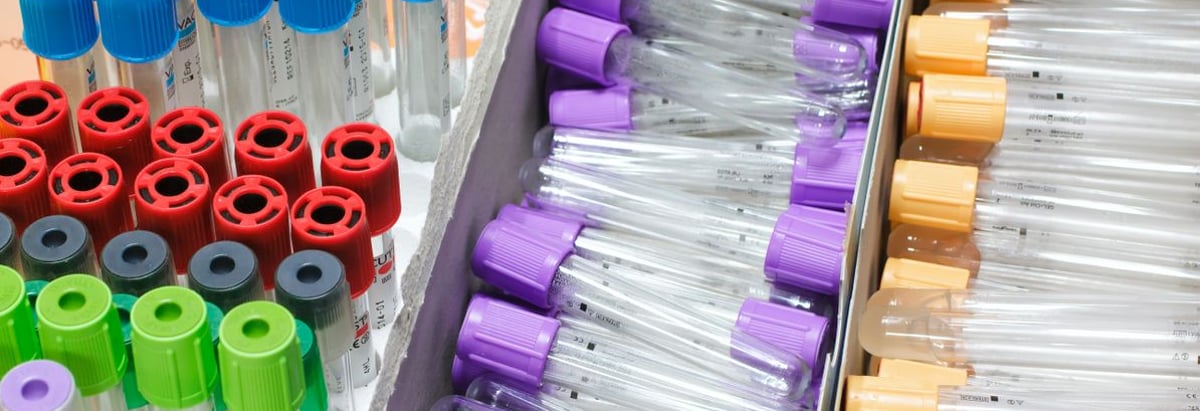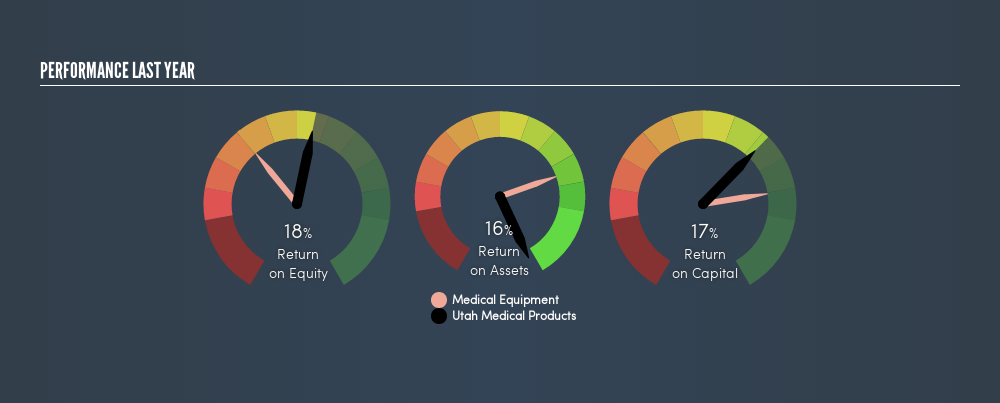- United States
- /
- Medical Equipment
- /
- NasdaqGS:UTMD
Should You Like Utah Medical Products, Inc.’s (NASDAQ:UTMD) High Return On Capital Employed?

Today we are going to look at Utah Medical Products, Inc. (NASDAQ:UTMD) to see whether it might be an attractive investment prospect. In particular, we'll consider its Return On Capital Employed (ROCE), as that can give us insight into how profitably the company is able to employ capital in its business.
First of all, we'll work out how to calculate ROCE. Then we'll compare its ROCE to similar companies. Then we'll determine how its current liabilities are affecting its ROCE.
Understanding Return On Capital Employed (ROCE)
ROCE measures the amount of pre-tax profits a company can generate from the capital employed in its business. All else being equal, a better business will have a higher ROCE. Overall, it is a valuable metric that has its flaws. Author Edwin Whiting says to be careful when comparing the ROCE of different businesses, since 'No two businesses are exactly alike.'
So, How Do We Calculate ROCE?
Analysts use this formula to calculate return on capital employed:
Return on Capital Employed = Earnings Before Interest and Tax (EBIT) ÷ (Total Assets - Current Liabilities)
Or for Utah Medical Products:
0.17 = US$17m ÷ (US$103m - US$3.8m) (Based on the trailing twelve months to June 2019.)
So, Utah Medical Products has an ROCE of 17%.
View our latest analysis for Utah Medical Products
Is Utah Medical Products's ROCE Good?
One way to assess ROCE is to compare similar companies. Utah Medical Products's ROCE appears to be substantially greater than the 10% average in the Medical Equipment industry. We would consider this a positive, as it suggests it is using capital more effectively than other similar companies. Regardless of where Utah Medical Products sits next to its industry, its ROCE in absolute terms appears satisfactory, and this company could be worth a closer look.

Remember that this metric is backwards looking - it shows what has happened in the past, and does not accurately predict the future. Companies in cyclical industries can be difficult to understand using ROCE, as returns typically look high during boom times, and low during busts. ROCE is only a point-in-time measure. You can check if Utah Medical Products has cyclical profits by looking at this free graph of past earnings, revenue and cash flow.
Do Utah Medical Products's Current Liabilities Skew Its ROCE?
Short term (or current) liabilities, are things like supplier invoices, overdrafts, or tax bills that need to be paid within 12 months. The ROCE equation subtracts current liabilities from capital employed, so a company with a lot of current liabilities appears to have less capital employed, and a higher ROCE than otherwise. To counter this, investors can check if a company has high current liabilities relative to total assets.
Utah Medical Products has total assets of US$103m and current liabilities of US$3.8m. As a result, its current liabilities are equal to approximately 3.7% of its total assets. In addition to low current liabilities (making a negligible impact on ROCE), Utah Medical Products earns a sound return on capital employed.
Our Take On Utah Medical Products's ROCE
If Utah Medical Products can continue reinvesting in its business, it could be an attractive prospect. Utah Medical Products shapes up well under this analysis, but it is far from the only business delivering excellent numbers . You might also want to check this free collection of companies delivering excellent earnings growth.
If you like to buy stocks alongside management, then you might just love this free list of companies. (Hint: insiders have been buying them).
We aim to bring you long-term focused research analysis driven by fundamental data. Note that our analysis may not factor in the latest price-sensitive company announcements or qualitative material.
If you spot an error that warrants correction, please contact the editor at editorial-team@simplywallst.com. This article by Simply Wall St is general in nature. It does not constitute a recommendation to buy or sell any stock, and does not take account of your objectives, or your financial situation. Simply Wall St has no position in the stocks mentioned. Thank you for reading.
About NasdaqGS:UTMD
Utah Medical Products
Provides medical devices for the healthcare industry worldwide.
Flawless balance sheet established dividend payer.
Similar Companies
Market Insights
Community Narratives



